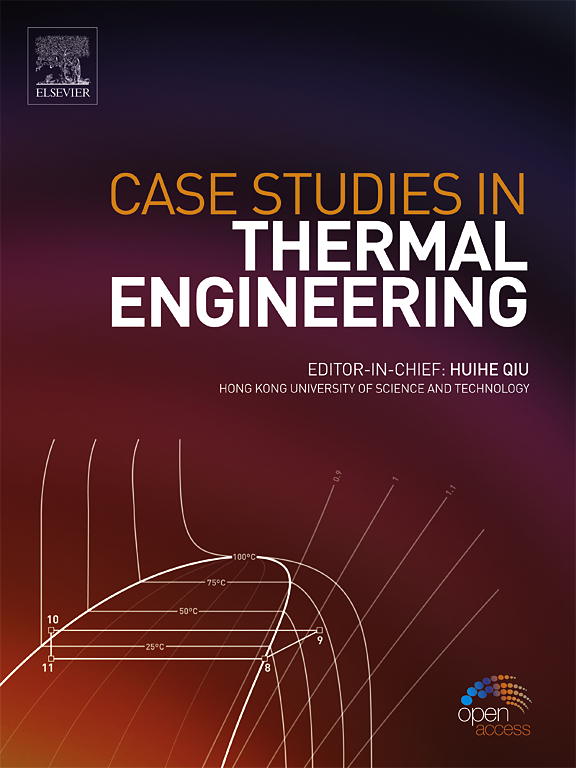Assessment of textile sludge pyrolysis behaviour through advance predictive models for bioenergy production
IF 6.4
2区 工程技术
Q1 THERMODYNAMICS
引用次数: 0
Abstract
Managing the textile sludge has become a significant global challenge because it is often disposed of in landfills without recovering its energy potential. Pyrolysis has emerged as a promising technology to extract energy and valuable chemicals from textile sludge. This study investigates the pyrolysis of textile sludge through thermogravimetric analysis (TGA) conducted from ambient temperature to 1000 °C at three different heating rates of 2.5, 5 and 7.5 °C/min in an inert environment. The kinetic study complemented was isoconversional method which includes both differential and integral (Friedman, Ozawa-Flynn-Wall & Kissinger-Akahira-Sunose) method. Moreover, five pseudo-components (pc1, pc2, pc3, pc4, pc5) were obtained by multi distributed activation energy model (M-DAEM). Additionally, combined kinetics retrieves the Ea of 98.3(±3.6) kJ/mol with R通过生物能源生产的先进预测模型评估纺织污泥热解行为
纺织污泥的管理已成为一项重大的全球性挑战,因为它往往被处理在垃圾填埋场没有回收其能源潜力。热解是一种从纺织污泥中提取能量和有价化学物质的有前途的技术。本研究通过热重分析(TGA)研究了纺织污泥在惰性环境中以2.5、5和7.5℃/min三种不同的加热速率从室温到1000℃的热解过程。动力学研究的补充是微分和积分等转换方法(Friedman, Ozawa-Flynn-Wall &;Kissinger-Akahira-Sunose)方法。利用多分布活化能模型(M-DAEM)得到5个伪分量(pc1、pc2、pc3、pc4、pc5)。联合动力学的Ea为98.3(±3.6)kJ/mol, R2为0.9924。此外,在固定床反应器(FBR)中对纺织污泥在500°C下进行热解,热解产物为焦油、不凝性气体和生物炭,产率分别为17.5(±1.7)%、13.7(±3)%和68.8(±1.3)%。为了优化纺织污泥的热解,有必要了解其降解的复杂动力学。人工神经网络(ANN)、分类与回归树(C&;RT)、增强回归树(BRT)和K近邻(KNN)等机器学习模型用于预测活化能(Ea),其中ANN的预测能力优于其他模型(R2=0.999)。本研究证明了ANN、C&;RT、BRT和KNN在准确分析纺织污泥热解复杂关系、预测纺织污泥热解动力学方面的卓越能力,证实了纺织污泥热解作为一种可持续高效能源的潜力。
本文章由计算机程序翻译,如有差异,请以英文原文为准。
求助全文
约1分钟内获得全文
求助全文
来源期刊

Case Studies in Thermal Engineering
Chemical Engineering-Fluid Flow and Transfer Processes
CiteScore
8.60
自引率
11.80%
发文量
812
审稿时长
76 days
期刊介绍:
Case Studies in Thermal Engineering provides a forum for the rapid publication of short, structured Case Studies in Thermal Engineering and related Short Communications. It provides an essential compendium of case studies for researchers and practitioners in the field of thermal engineering and others who are interested in aspects of thermal engineering cases that could affect other engineering processes. The journal not only publishes new and novel case studies, but also provides a forum for the publication of high quality descriptions of classic thermal engineering problems. The scope of the journal includes case studies of thermal engineering problems in components, devices and systems using existing experimental and numerical techniques in the areas of mechanical, aerospace, chemical, medical, thermal management for electronics, heat exchangers, regeneration, solar thermal energy, thermal storage, building energy conservation, and power generation. Case studies of thermal problems in other areas will also be considered.
 求助内容:
求助内容: 应助结果提醒方式:
应助结果提醒方式:


